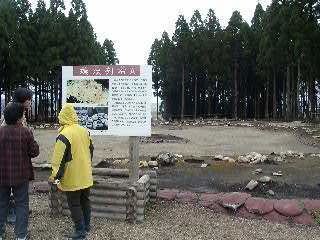Region JP Founded 2000 BCE Ownership Public Period Jōmon period | Type landmark Periods Jōmon period Phone +81 186-84-8710 | |
 | ||
Area 200,000 square metres (2,200,000 sq ft) Address Japan, 〒018-3454 秋田県北秋田市 脇神字小ヶ田中田100−1 伊勢堂岱縄文館 Hours Open today · 9AM–5PMThursday9AM–5PMFriday9AM–5PMSaturday9AM–5PMSunday9AM–5PMMonday(Vernal Equinox Day)ClosedTuesday9AM–5PMWednesday9AM–5PM Similar Ōyu Stone Circles, Ogata Station, Odai Yamamoto I site, Sannai‑Maruyama site, Takanosu Station | ||
Isedōtai Site (伊勢堂岱遺跡, Isedōtai iseki) is a late Jōmon period archaeological site in the city of Kitaakita, Akita Prefecture, in the Tōhoku region of northern Japan. Discovered during the construction of a highway to nearby Odate–Noshiro Airport, the remains were designated a National Historic Site of Japan in 2001 by the Japanese government. The site is located approximately five minutes on foot from Ogata on the Akita Nairiku Railway.
Site
The site consists of three large stone circles located on an artificially flattened plateau on the west bank of the Yoneshiro River. The largest circle is between 42 and 45 meters in diameter, and completely encloses a fourth stone circle. The stones, including porphyrite, rhyolite and tuff, were brought from rivers up to five kilometers away, and the site has a moat on its eastern side with a length of more than 100 meters. More than 100 pits have been found, both inside and outside the stone circles, containing terracotta plates and jars, and small clay objects along with hunting and fishing implements and everyday tools. No bones have been found, but soil discoloration indicates that the site was a necropolis and the objects found were ritual or grave-goods. Some 200 clay dogu have also been found on the site, many of which appear to have been intentionally broken. One of the stone circles contains a standing stone which appears to have served as a sun dial.
Next to the stone circles, post holes indicate that as many as 37 pit-houses with a width of 3–5 meters and length of 6–7 meters were built on the site, although there is no indication that this was a permanently inhabited settlement.
There are no public facilities at site. Many of the artifacts recovered from the site are on display at the Kitaakita city Community Center.
The site has been submitted for inscription on the UNESCO World Heritage List as one of the Jōmon Archaeological Sites in Hokkaidō, Northern Tōhoku, and other regions
